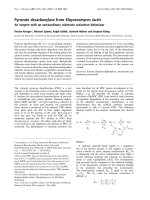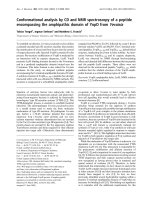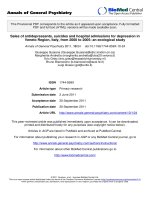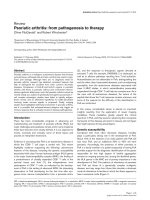Báo cáo y học: "Unanswered questions from Corticus and pragmatic suggestions" pps
Bạn đang xem bản rút gọn của tài liệu. Xem và tải ngay bản đầy đủ của tài liệu tại đây (40.3 KB, 2 trang )
Page 1 of 2
(page number not for citation purposes)
Available online />Professor Vincent, in an eloquent commentary in Critical
Care, calls for a further trial into supraphysiological cortico-
steroid therapy in vasopressor-resistant shock [1]. Together
with editorials in several of the intensive care journals, he has
pointed out many of the shortcomings in the Corticus trial [2].
We would like to add to this chorus by posing a further
question to the authors and putting forward some
suggestions. Regrettably, we are prohibited from addressing
these directly due to the Letters policy of the journal in which
the original paper was published.
Data from numerous sources suggest that the earlier shock is
reversed, the better the outcome – be it mortality, morbidity,
length of stay or other surrogate endpoints. In the Corticus
study, the median time to shock reversal was 2 to 3 days
shorter in the hydrocortisone group (see Table 1). Despite
this, no outcome improvement was demonstrated. No
investigation, or explanation, of this apparent discrepancy has
been forthcoming. Sequential Organ Failure Assessment
scores were performed at the time of study enrolment, but no
serial Sequential Organ Failure Assessment score data are
presented. If available, these data would be intriguing.
Following the publication of the Corticus data, a consensus
statement regarding the diagnosis and management of
corticosteroid insufficiency in critically ill adult patients has
been published [3]. Together with a detailed review by
Dickstein and Saiegh [4], this statement suggests a working
diagnostic paradigm. However, we would like to suggest the
following three pragmatic definitions of functional
hypoadrenalism, which future trial designers might with wish
to consider and which we currently employ.
First, patients with septic shock requiring high-dose vaso-
pressors – defined as requiring ≥0.2 μg/kg/minute norepi-
nephrine (or equivalent), who are not volume responsive
(defined as a ≥10% increase in stroke volume following a
3 ml/kg fluid bolus administered in ≤5 min) and who are
hyperdynamic (defined as a cardiac index ≥2.8 l/min/m
2
).
Patients with evidence of acute myocardial depression or
chronic insufficiency should be considered separately.
Second, patients who, having been stable for ≥2 hours on a
dose of vasopressor, develop increasing dose requirements
(≥20% increase), are unresponsive to a volume bolus (as
above) and are hyperdynamic (as above).
Third, patients whose dose of vasopressor cannot be weaned
≥24 hours following initiation of appropriate broad-spectrum
antimicrobial therapy and/or effective source control.
Furthermore, this therapy should be withdrawn from patients
who fail to demonstrate a ≥20% decrease in vasopressor
requirement to maintain the same mean arterial pressure
60 minutes after the initial dose of hydrocortisone. Due to the
pharmacokinetics of hydrocortisone, we favour a 100 mg
intravenous bolus followed immediately by initiation of a
10 mg/hour intravenous infusion.
Finally, we would like to promote two recently published
papers that offer useful insights into the pharmacodynamics
of supraphysiological steroid therapy in vasopressor-resistant
shock. Firstly, Druce and colleagues make a convincing
argument that the principal effect of hydrocortisone is as a
mineralocorticoid and not as an anti-inflammatory [5].
Letter
Unanswered questions from Corticus and pragmatic suggestions
Wolfgang Bauer, Jonathan Ball and Mike Grounds
General Intensive Care Unit, St George’s Hospital, London, SW17 0QT, UK
Corresponding author: Jonathan Ball,
Published: 14 August 2008 Critical Care 2008, 12:426 (doi:10.1186/cc6967)
This article is online at />© 2008 BioMed Central Ltd
See related commentary by Vincent, />Table 1
Time to shock reversal data from the Corticus study [2]
Median time to shock reversal (days)
Corticotrophin Corticotrophin
responders nonresponders All patients
Control 5.8 6.0 5.8
Hydrocortisone 2.8 3.9 3.3
Page 2 of 2
(page number not for citation purposes)
Critical Care Vol 12 No 4 Bauer et al.
Secondly, Kaufman and colleagues [6] found that hydro-
cortisone administered as described above does have some
arguably clinically valuable anti-inflammatory effects but, in
addition, enhances neutrophil phagocytosis. This has led us
to conclude that, in the absence of a systemic form of fludro-
cortisone and with the unreliable enteral absorption of drugs,
systemic hydrocortisone monotherapy at optimal mineralo-
corticoid doses should be the therapy of choice.
Authors’ response
Charles L Sprung, Djillali Annane, Didier Keh and Josef Briegel, for the Corticus Study Group
We thank Critical Care for the opportunity to respond to the
letter of Dr Bauer and colleagues. They question the apparent
discrepancy between a shorter time to shock reversal in the
hydrocortisone group and no outcome improvement, as did
the Corticus investigators. In the Corticus study we noted
that ‘The duration of the administration of corticosteroids may
be pertinent, with the possibility that any gain that was
achieved by an earlier reversal of shock was counterbalanced
by later complications’ [2]. Later we mention the
complications – ‘an increased incidence of superinfection,
including new episodes of sepsis or septic shock, in the
hydrocortisone group’ [2].
Two recent consensus statements with guidelines have been
published after reviewing the Corticus data [3,7], suggesting
that intravenous hydrocortisone be given only to adult septic
shock patients after their blood pressure has been confirmed
to be poorly responsive to fluid resuscitation and vasopressor
therapy. Although clinicians are frustrated with the lack of
explicit recommendations for thresholds for blood pressure,
volume resuscitation and vasopressor treatment, the group of
experts for both consensus statements – after deliberating
with this issue for many months – chose not to give more
explicit recommendations because there are simply
insufficient data to make such specific recommendations.
Experts may provide their own personal opinions and beliefs.
Unfortunately, until further quality studies provide answers to
the present uncertainties, clinicians will be forced to rely on
their expertise in providing the art of medicine and not only
the science of medicine.
Competing interests
The authors declare that they have no competing interests.
References
1. Vincent JL: Steroids in sepsis: another swing of the pendulum
in our clinical trials. Crit Care 2008, 12:141.
2. Sprung CL, Annane D, Keh D, Moreno R, Singer M, Freivogel K,
Weiss YG, Benbenishty J, Kalenka A, Forst H, Laterre PF, Rein-
hart K, Cuthbertson BH, Payen D, Briegel J: Hydrocortisone
therapy for patients with septic shock. N Engl J Med 2008,
358:111-124.
3. Marik PE, Pastores SM, Annane D, Meduri GU, Sprung CL, Arlt
W, Keh D, Briegel J, Beishuizen A, Dimopoulou I, Tsagarakis S,
Singer M, Chrousos GP, Zaloga G, Bokhari F, Vogeser M: Rec-
ommendations for the diagnosis and management of corti-
costeroid insufficiency in critically ill adult patients:
consensus statements from an international task force by the
American College of Critical Care Medicine. Crit Care Med
2008, 36:1937-1949.
4. Dickstein G, Saiegh L: Low-dose and high-dose adrenocorti-
cotropin testing: indications and shortcomings. Curr Opin
Endocrinol Diabetes Obes 2008, 15:244-249.
5. Druce LA, Thorpe CM, Wilton A: Mineralocorticoid effects due
to cortisol inactivation overload explain the beneficial use of
hydrocortisone in septic shock. Med Hypotheses 2008, 70:56-
60.
6. Kaufmann I, Briegel J, Schliephake F, Hoelzl A, Chouker A,
Hummel T, Schelling G, Thiel M: Stress doses of hydrocorti-
sone in septic shock: beneficial effects on opsonization-
dependent neutrophil functions. Intensive Care Med 2008, 34:
344-349.
7. Dellinger RP, Levy MM, Carlet JM, et al., for the International Sur-
viving Sepsis Campaign Guidelines Committee: Surviving
Sepsis Campaign: international guidelines for management
of severe sepsis and septic shock: 2008. Crit Care Med 2008,
36:296-327.









